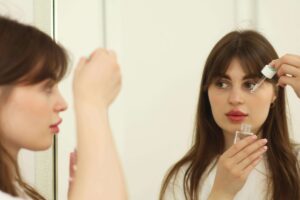What to Look For

In recent years, the beauty industry has witnessed a transformative shift towards clean beauty. Consumers are becoming increasingly conscious of the ingredients they apply to their skin and are demanding transparency from beauty brands. However, navigating the world of clean beauty labels can be like deciphering a secret code. In this beauty blog, we will decode the language of clean beauty labels, empowering you to make informed choices about the products you bring into your skincare and makeup routine.
Understanding Clean Beauty
1. Natural and Organic:
- The terms “natural” and “organic” are often used interchangeably, but they have distinct meanings. “Natural” implies that the ingredients are derived from nature, while “organic” indicates that the ingredients are grown without synthetic pesticides or fertilizers. Look for certifications like USDA Organic for credibility.
2. Vegan:
- A vegan product excludes all animal-derived ingredients, including honey, beeswax, and lanolin. Look for the certified vegan logo, ensuring that the product aligns with ethical and cruelty-free standards.
3. Cruelty-Free:
- Cruelty-free products are not tested on animals. The Leaping Bunny or PETA’s cruelty-free logo indicates that a brand is committed to cruelty-free practices. However, it’s essential to note that cruelty-free doesn’t necessarily mean vegan.
Navigating Ingredient Lists: What to Avoid
1. Parabens:
- Parabens are synthetic preservatives that have raised concerns about potential links to hormonal disruption. Look for paraben-free labels, and instead, opt for products using natural preservatives like vitamin E.
2. Sulfates:
- Sulfates, such as sodium lauryl sulfate (SLS), are harsh detergents often found in cleansers and shampoos. They can strip the skin of natural oils and cause irritation. Clean beauty products use gentler alternatives like coconut-derived cleansers.
3. Phthalates:
- Phthalates are plasticizers that may disrupt the endocrine system. Clean beauty avoids these chemicals, and you’ll find products proudly labeled as phthalate-free.
4. Synthetic Fragrances:
- Synthetic fragrances can contain hidden chemicals that may trigger allergies or skin sensitivities. Look for products with natural fragrances or those explicitly stating they are free from synthetic fragrances.
5. Mineral Oil:
- Mineral oil is a byproduct of petroleum that is commonly used in skincare products. It’s considered non-comedogenic, but clean beauty often opts for plant-based oils like jojoba, argan, or almond oil instead.
Certifications and Seals: Trusting the Labels
1. EWG Verified:
- The Environmental Working Group (EWG) verifies products that meet their strict criteria for transparency and safety. Products with the EWG Verified seal adhere to high standards for ingredient safety.
2. USDA Organic:
- The United States Department of Agriculture (USDA) Organic certification ensures that products are made with a high percentage of organic ingredients. Look for the USDA Organic seal on skincare and personal care products.
3. Leaping Bunny:
- The Leaping Bunny logo certifies that a brand is cruelty-free and has committed to not testing on animals at any stage of product development. It’s a reliable indicator of ethical practices.
4. Clean at Sephora:
- Sephora’s Clean at Sephora seal identifies products that meet the retailer’s standards for clean beauty. These products are free from certain ingredients like sulfates, parabens, and more.
Common Greenwashing Tactics
1. Ambiguous Terminology:
- Be wary of terms like “green,” “eco-friendly,” or “all-natural” without clear certifications. These phrases are often subjective and can be used to create a false sense of cleanliness.
2. Excessive Packaging:
- Some brands may focus on eco-friendly packaging but may not necessarily have clean formulations. Look beyond the outer packaging and delve into ingredient lists and certifications.
3. Lack of Transparency:
- Clean beauty emphasizes transparency. If a brand is vague about its ingredient sources or refuses to disclose the full list of components, it might be concealing something.
The Power of Educated Choices
1. Research Brands and Ingredients:
- Familiarize yourself with brands committed to clean beauty principles and regularly check ingredient lists. Resources like the Environmental Working Group’s Skin Deep database can be valuable.
2. Start with Essentials:
- If overwhelmed, begin by transitioning your essential products like cleansers, moisturizers, and foundations to clean alternatives. Gradually expand to other beauty categories.
3. Stay Informed:
- The beauty industry is dynamic, with new clean beauty brands emerging regularly. Stay informed about the latest in clean beauty by following reputable beauty bloggers, reading reviews, and staying updated on certifications.

As the clean beauty movement continues to gain momentum, deciphering labels becomes a valuable skill. By understanding the language of clean beauty labels, you empower yourself to make conscious choices that align with your values. Whether you’re a clean beauty enthusiast or just beginning your journey, let knowledge guide your path to a skincare and makeup routine that not only enhances your beauty but also supports your overall well-being and the health of the planet.




